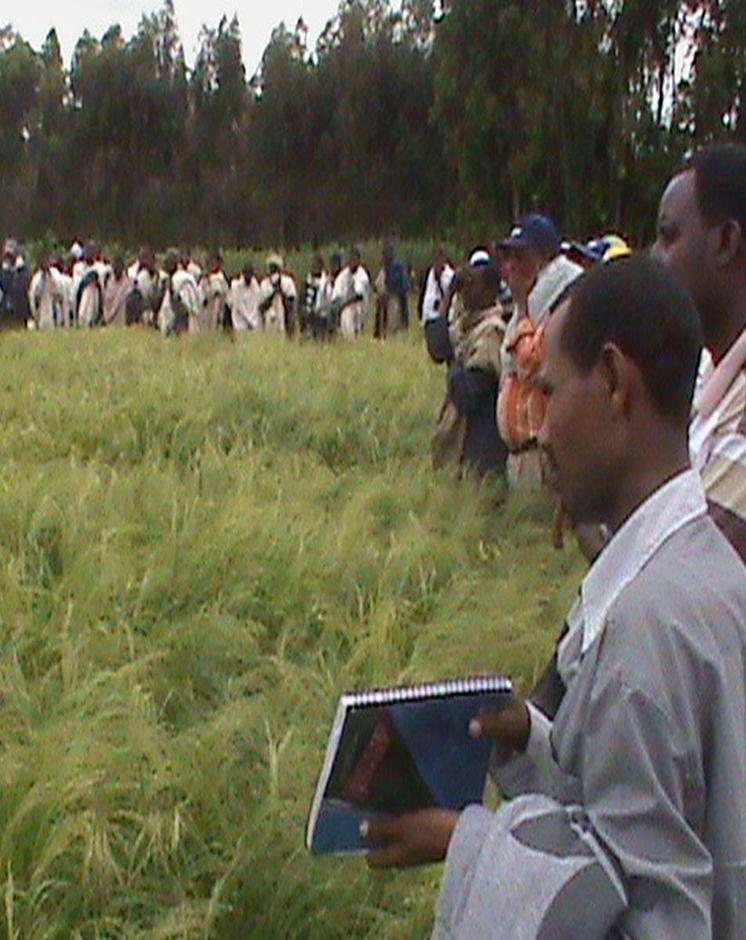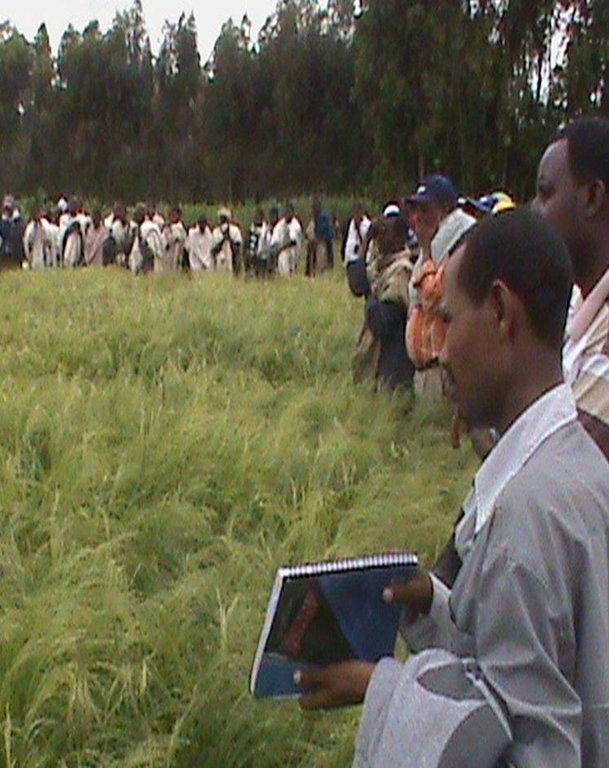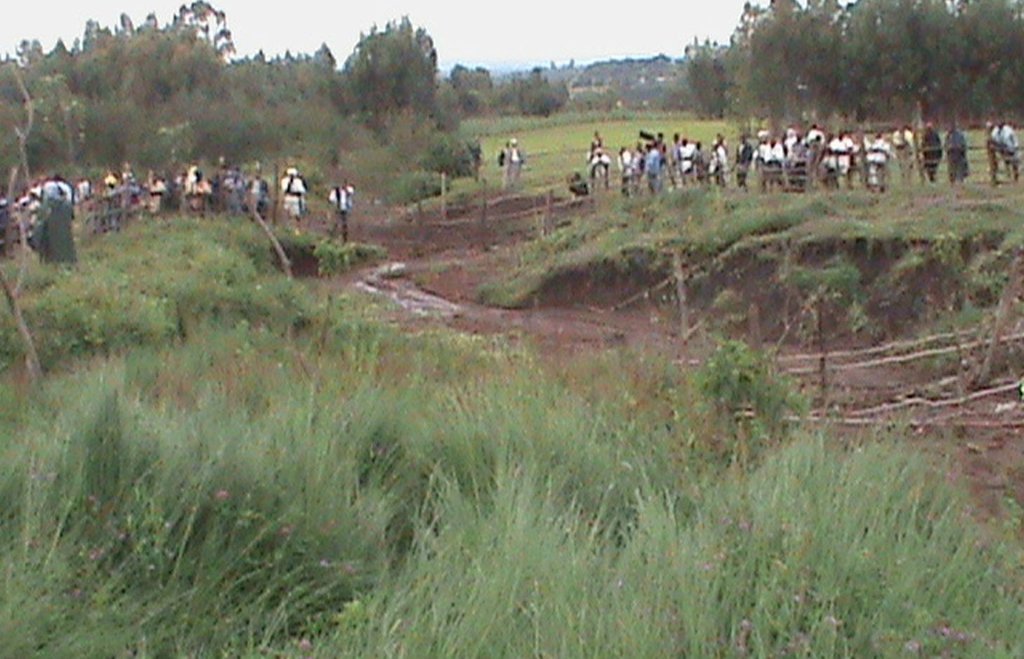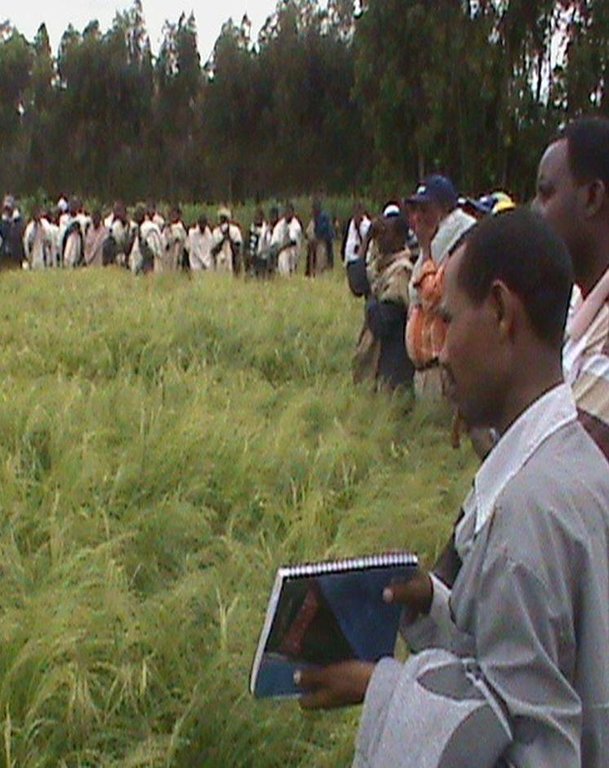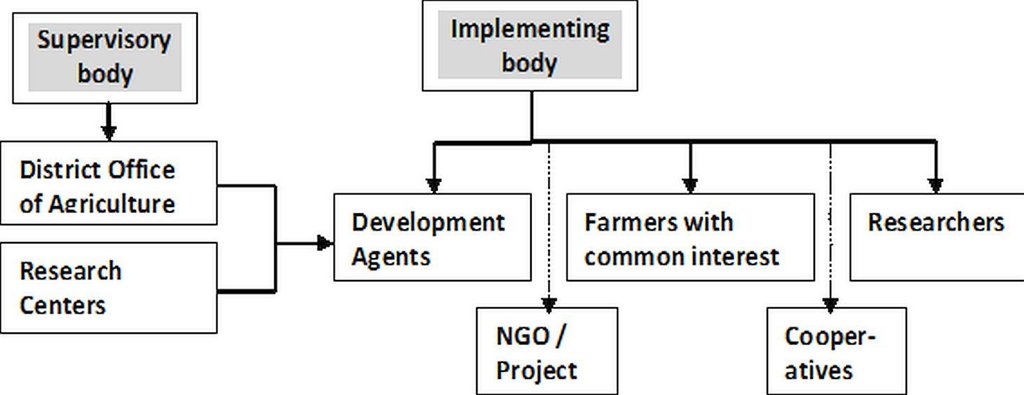Farmer-Research-Extension Group (FREG) [埃塞俄比亚]
- 创建:
- 更新:
- 编制者: Gizaw Desta Gessesse
- 编辑者: –
- 审查者: Fabian Ottiger
Yearsoader temeramari buden (Amharic)
approaches_2496 - 埃塞俄比亚
查看章节
全部展开 全部收起1. 一般信息
1.2 参与方法评估和文件编制的资源人员和机构的联系方式
有助于对方法进行记录/评估的机构名称(如相关)
Water and Land Resource Centre (WLRC) - 埃塞俄比亚1.3 关于使用通过WOCAT记录的数据的条件
(现场)数据是什么时候汇编的?:
26/05/2014
编制者和关键资源人员接受有关使用通过WOCAT记录数据的条件。:
是
1.4 SLM技术问卷的参考
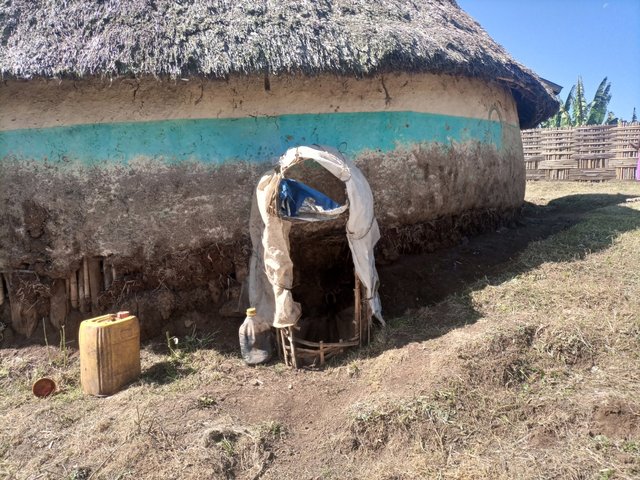
Livestock Urine Collection and Use [埃塞俄比亚]
Collection of livestock urine allows resource-poor farmers to capture nutrient-rich livestock waste and use it to substitute urea fertilizer. It is a liquid organic product that restores soil fertility and pest management.
- 编制者: GERBA LETA
2. SLM方法的描述
2.1 该方法的简要说明
Farmer-Research-Extension Group (FREG) is a grass root level platform aims to bridge gaps on agricultural technology transfer between research and extension linkage and provide a platform of 20-30 members from research, extension and farmer for their joint learning and active participatory role in agricultural technology evaluation and dessimination.
2.2 该方法的详细说明
该方法的详细说明:
Aims / objectives: FREG aims to facilitate the selection and transfer of agricultural technologies to end users through active participation and coordinated efforts of research-extension and farmer together. The objectives of FREG are: 1) evaluating and selecting improved agricultural technologies through participatory processes at field level, 2) demonstrating improved agricultural technologies to FREG members and other non-member land users in the villages, 3) facilitating farmer to farmer knowledge and technology exchange for faster and wider dissemination and adoption
Methods: In FREG, research takes initiation to facilitate the formation. The group is expected to identify and prioritize problems of their locality on its own and research and extension organizations could take facilitation to form or organize groups based on specific objectives. If the intention is to provide a range of technological options to fit needs and interests of farmers, it can be best developed with participation and through knowledge sharing among stakeholders (research, extension and farmer). Thus, group formation is based on individual and group interests. Those farmers who have similar interests are organized into a group based on proximity including both male and women farmers. Next, the group establish norms, share responsibility, design activity plan, and implement activities. The group meets regularly to evaluate performance of technologies at different stages. During each meeting, it is critical to visit on-farm activities of individual members and assess the relative performance. They develop their own criteria to rank and select the best technologies. Finally, they participate in field days and decide the best technologies for scale up to wider areas.
Stages of implementation: 1. Conduct awareness meeting of farmers about the available technologies for demonstration and scale up and their merits compared to the existing technologies in the hands of farmers.
2. Based on the awareness creation, collect the demands and interests of farmers in which of the technology options they want to involve. Organize into groups according to common interests.
3. Prepare and conduct training about the characteristics of available technologies, procedures of on-farm implementation and evaluation, farmer to farmer technology transfer, and work norms
4. FREG members develop their working norms, decide on the period of meetings, and develop plan of activities
5. Implement on-farm activities and evaluate the performance of planned activities on regular basis
6. Evaluate and rank the technology options based on their own criteria in order to select the best technologies
7. Organize field days to demonstrate and exchange the results of technology options to other non-member farmers and stakeholders. The technologies selected through FREG participatory evaluation procedures need to be supported with research evidences by ARARI.
8. Finally, each member farmer who is involved in on-farm technology evaluation took the responsibility to transfer the selected technology to at least 3-5 other farmers in his locality in order to facilitate quick dissemination, scaling up.
Role of stakeholders: Farmer: The farmers who have common interest on a given technology is responsible to lead the participatory technology selection
Development agents/extension: they should play facilitation and motivation role and help to encourage farmers to become member of FREG. They also follow up whether the FREG accomplish the planned activities and attend regular meetings
Research: research is involved in demonstration of technologies, in the initiation and establishment of FREG and plays a role of facilitation and technology supply. Research need to organize field days and advice other stakeholders to participate in the process
Project/WLRC: Provide material and technical support for the FREG and participate in the meetings and field days
Other stakeholders: The involved actors in the area should actively participate as a FREG member and during field days.
2.3 该方法的照片
2.5 采用该方法的国家/地区/地点
国家:
埃塞俄比亚
区域/州/省:
Amhara National Regional State
有关地点的进一步说明:
Bahir Dar Zuria, Dembecha, Mecha, Yilmna Densa, Dessie Zuria, Basona Worana
2.6 该方法的开始和终止日期
注明开始年份:
2005
2.7 方法的类型
- 基于项目/方案
2.8 该方法的主要目的/目标
The Approach focused mainly on other activities than SLM (Participatory technology evaluation and selection, awareness creation, training, field visits, field days)
The main objective of FREG is to facilitate the participation and involvement of farmers, researchers and extension agents together in technology evaluation, selection and dessimination.
The SLM Approach addressed the following problems: The main problems targeted to address by implementing FREG approach are: low dissemination and adoption of agricultural and natural resource management technologies; linkage gap between research, who generate technologies, and extension who transfer and disseminate technologies; and low participation and involvement of farmers in technology development and selection processes.
2.9 推动或妨碍实施本办法所适用的技术的条件
财务资源和服务的可用性/可得性
- 阻碍
Low capacity of farmers to afford and use improved technologies
Treatment through the SLM Approach: The approach allows options of in-kind exchange, transfer and dissemination of technologies from farmer to farmer without incurring much cost to them
机构设置
- 阻碍
Inadequate linkage between research and extension that lead to low supply and transfer of technologies
Treatment through the SLM Approach: The FREG is the best link at grass root level where the demand (extension-farmer) and supply (research) can effectively interface
法律框架(土地使用权、土地和水使用权)
- 阻碍
The existing land ownership, land use rights / water rights hindered a little the approach implementation Since FREG approach is implemented on individual farm plots, entitlement of individual land use right is essential to invest on new agricultural technologies. At same time, water use right has contributed a lot to implement technologies working under irrigated and water harvesting systems. For example, if farmers are not allowed to dig shallow wells and divert streams it was not able to demonstrate and implement home garden in all watersheds and chickpea varieties at Debre Yacob
了解SLM,获得技术支持
- 阻碍
Lack of information about availability of technologies and inadequate participation of farmers in technology evaluation and selection processes that partly result in low adoption of existing technologies.
Treatment through the SLM Approach: The FREG approach provides choice of technologies for farmers and extension agents and take part in the evaluation and selection of technologies that fit to the system for wider adoption
3. 相关利益相关者的参与和角色
3.1 该方法涉及的利益相关者及其职责
- 当地土地使用者/当地社区
Individual land users who have common interest on specific technology
Land users are active members and take the leading responsibility of the process
- SLM专家/农业顾问
Agricultural specialists and development agents
- 研究人员
Researchers has the role to facilitate and provide technologies
- 地方政府
The development agent together with kebele adminstration, District Agriculture Office Cooperative Agents for implementation and supervision
- 国家政府(规划者、决策者)
They were involved in the monitoring and evaluation stage
如果涉及多个利益相关者,请注明领导机构:
In FREG, both men and women can be members. Women play a great role in selecting technologies specially technologies related to food processing aspects
3.2 当地土地使用者/当地社区参与该方法的不同阶段
| 当地土地使用者/当地社区的参与 | 指定参与人员并描述活动 | |
|---|---|---|
| 启动/动机 | 被动 | Land users has no involvement in the initiation of the approach. Land users are part of the process after the planning phase. |
| 计划 | 互动 | At planning stage of the approach, land users' are needed to express their interests and needs of technology options, and their interest to form a group. Land users participate by expressing their technology needs once information about available technology options is provided by the researchers and development agents. |
| 实施 | 互动 | Land users are expected beeing actively involved in every stage of the implementation and take the leading responsibility to all activities such as site selection, seed bed preparation, planting, cultivation, harvesting and reporting the productivity. |
| 监测/评估 | 互动 | Land users are responsible to regularly evaluate the technologies and select the best for promotion and further scale up activities |
| Research | 互动 | In the FREG approach, participatory technology evaluation and selection is the key element. Thus the land users are allowed to evaluate and select best and suitable ones among several options |
3.3 流程图(如可用)
具体说明:
The district office of agriculture and research centers within ARARI are the supervisory bodies for the implementation of the FREG approach. The main implementer are the member farmers in the group, the researcher and development agent at kebele level. Depending on the availability and interest, NGOs/ Projects and cooperative agents are involved in the implementation of the process.
作者:
Gizaw Desta (WLRC, P.O.Box 8707, Addis Abeba, Ethiopia)
3.4 有关SLM技术选择的决策
具体说明谁有权决定选择要实施的技术:
- 主要是土地使用者,由SLM专家提供支持
解释:
Different options of adapted technologies are supplied from research and the farmers can decide and choose the type of technology for demonstration and scale up
Decisions on the method of implementing the SLM Technology were made by mainly by SLM specialists with consultation of land users. Researchers and development agents with active participation of the FREG member farmers decide on the method of implementation
4. 技术支持、能力建设和知识管理
4.1 能力建设/培训
是否为土地使用者/其他利益相关者提供培训?:
是
明确受训人员:
- 土地使用者
- 现场工作人员/顾问
- Other development agents are involved in cooperatives and other agr. development actions
如果相关,请说明性别、年龄、地位、种族等。:
It includes all land users who are members of FREG including women.
培训形式:
- 在职
- 农民对农民
- 示范区域
涵盖的主题:
Awareness creation and characteristics of the technology, merits of new technologies compared to locally available and adapted technologies, procedures of implementing the technology evaluation and selection, the participation and involvement of FREG members at each stage of the implementation are contents of the training for FREG members before they start implementation.
Development agents and some experts from the district as well as project/NGO offices are contributing to the trainings about the implementation procedures and monitoring and evaluation activities.
4.2 咨询服务
土地使用者有权使用咨询服务吗?:
是
指明是否提供了咨询服务:
- 在固定中心
说明/注释:
Name of method used for advisory service: Participatory Demonstration and Training Extension System (PADETES); Key elements: Training and awareness creation of farmers in FTCs , Provision of package of technologies, demonstrations in the Farmer Training Centers (FTC) and experience sharing visits, On job training; The method gives high emphasis to training and to some extent practical demonstrations supported with experience
sharing visits but less emphasis to advisory of farmers on spot
Advisory service is quite adequate to ensure the continuation of land conservation activities; The government service at Kebele level is adequate to ensure the implementation of FREG approach through active involvement of the development agents.
4.3 机构强化(组织发展)
是否通过这种方法建立或加强了机构?:
- 是,适度
具体说明机构的强化或建立程度:
- 本地
具体说明支持类型:
- 能力建设/培训
提供进一步细节:
Moderate support with awareness creation, training, and supply of some equipments. The local institutions like FREG and Farmer Training Centers (FTCs) are supported by training, and training and demonstration aid facilities
4.4 监测和评估
监测和评估是该方法的一部分吗?:
是
注释:
bio-physical aspects were ad hoc monitored by government, land users through observations; indicators: growth performance of varieties or breeds, occurrence of disease and pests
bio-physical aspects were regular monitored by project staff, government through measurements; indicators: amount of inputs applied and labor, production and productivity of comparative technologies by WLRC and ARARI
socio-cultural aspects were regular monitored by project staff, government through measurements; indicators: Change in attitude of technology use, collective action within the group, productivity and economic benefits, exchange of knowledge and technology, transfer and dissemination rate measured jointly by WLRC and ARARI
area treated aspects were ad hoc monitored by project staff, government, land users through observations; indicators: Type of technology, number of users per technology, area covered by the technology
area treated aspects were regular monitored by project staff, government through measurements; indicators: Type of technology and number of users per technology by WLRC
There were several changes in the Approach as a result of monitoring and evaluation: After the monitoring and evaluation, the number of users increase, high demand and request for additional technologies, improved management of the technology were observed.
There were few changes in the Technology as a result of monitoring and evaluation: It sometimes occurs where there are more superior new technologies. For example, Faba Bean varieties were changed by superior one called Wolki variety.
4.5 研究
研究是该方法的一部分吗?
是
明确话题:
- 经济/市场营销
- 技术
提供进一步的细节,并指出是谁做的研究:
Research play role of initiation of the approach, facilitate the processes, take part in the implementation, monitoring and evaluation, advisory services, supply of the technologies demanded by FREG members, and evaluate the costs and benefits of the demonstrated technologies. The research centers in 2.3.1.1 (i.e., five research centers within the Amhara Region Agricultural Research Institute, ARARI) are fully responsible to conduct demonstrations, pr-extension dissemination of technologies and socio-economic research activities through the FREG
Research was carried out on-farm
5. 融资和外部物质支持
5.1 该方法中SLM组成部分的年度预算
如果不知道准确的年度预算,请给出一个范围:
- 100,000-1,000,000
注释(例如主要的资助来源/主要捐助者):
Approach costs were met by the following donors: local government (district, county, municipality, village etc) (Research centers (5 research centers within the Amhara Region Agricultural Reserch Institute, ARARI) provide capacity building through training and field visits, and supply of inputs (improved varieties) land allocation, fertilizer, labor): 15.0%; local community / land user(s) (land users contribute fertilizer, labor and allocate land for implementation): 85.0%
5.2 为土地使用者提供财政/物质支援
土地使用者是否获得实施该技术的财政/物质支持?:
是
5.3 对特定投入的补贴(包括劳动力)
- 农业
| 具体说明哪些投入得到了补贴 | 程度如何 | 对补贴做出具体说明 |
|---|---|---|
| 种子 | 充分融资 | |
| fruits, tree seedlings, breeds | 充分融资 | |
如果土地使用者的劳动力是一项重要的投入,那么是不是:
- 自愿
注释:
Labor to implement on-farm activities is covered by the FREG member or in group voluntarily
5.4 信用
是否根据SLM活动的方法给予信用值?:
是
对条件(利率、回报等)进行具体说明:
Credit is only partly available for specific technology types such as sheep breeds, fattening, potato seed storage and cooperative establishments, apiary
6. 影响分析和结论性陈述
6.1 方法的影响
该方法是否帮助土地使用者实施和维护SLM技术?:
- 否
- 是,很少
- 是,中等
- 是,支持力度很大
The approach helps to improve sustainable land management indirectly. Farmers who practiced improved technologies increase their productivity per unit area and are thereby capable to purchase more inputs and apply improved sustainable land management technologies. Those who earn high income can afford to invest on sustainable land management.
该方法是否有助于社会和经济弱势群体?:
- 否
- 是,很少
- 是,中等
- 是,支持力度很大
Youth groups who are organized to provide services to farmers by operating and threshing teff and finger millet using introduced threshers gain some benefits. Women FREG households involved in sheep, poultry and energy saving stove production activities got benefit and improved their situation
该方法是否改善了阻碍SLM技术实施的土地使用权/用户权问题?:
- 否
- 是,很少
- 是,中等
- 是,支持力度很大
The problem is unlikely to be overcome in the near future. The land ownership or land use rights is highly associated with increase in population and then lead to land fragmentation. This implies the need for policy actions on land use rights.
Did other land users / projects adopt the Approach?
- 否
- 是,很少
- 是,中等
- 是,支持力度很大
The approach and/or technology transfer and utilization is gradually expanded to other villages and adjacent watersheds through farmer to farmer technology transfer and share of experiences during field days.
Did the Approach lead to improved livelihoods / human well-being?
- 否
- 是,很少
- 是,中等
- 是,支持力度很大
Using the approach, FREG members and some non-members particularly those who were involved in the production of teff, potato, wheat, barley, and faba bean had improved varieties; in the production of improved breeds of sheep and poultry they hac improved their livelihood situation. Some land users who also produced potato and forage seeds for sale were also benefited. In some watersheds, crop damages by rodent flocks were extremely minimized. FREG members who took part in manual maize sheller and multi-crop thresher technology promotion activities were highly benefited in saving high labor requirement.
Did the Approach help to alleviate poverty?
- 否
- 是,很少
- 是,中等
- 是,支持力度很大
FREG members who were involved in the production of improved agricultural technologies are gradually going to improve their poverty situation.
6.2 土地使用者实施SLM的主要动机
- 增加生产
The immediate interest and objectives of farmers is to increase productivity per unit of their land
- 支付/补贴
Initially some have been motivated by giving them access to improved technologies & inputs
- well-being and livelihoods improvement
They realized that the approache ultimately can improve production, income and livelihood
6.3 方法活动的可持续性
土地使用者能否维持通过该方法实施的措施(无外部支持的情况下)?:
- 是
若是,请说明如何维持:
The technologies remain for long in the hands of FREG member farmers. They continue to produce the technology and disseminate in the area through farmer to farmer dissemination system. FREG members acquire capacity to access new technologies from research, extension and input supply seed agencies using the established linkage mechanism. Finally, these ensure sustainability of the approach that aim the transfer and adoption of technologies by farmers
6.4 该方法的长处/优点
| 土地使用者眼中的长处/优势/机会 |
|---|
| Increase the supply of new technologies. (How to sustain/ enhance this strength: Strengthen and expand FREG approach, and the role of research and seed enterprises.) |
| 编制者或其他关键资源人员认为的长处/优势/机会 |
|---|
| Improves communication and information exchange thereby improving social relations. (How to sustain/ enhance this strength: Can be used as an entry point for social learning a process by which stakeholders in a group learn how to innovate and adopt in response to changing social and environmental conditions.) |
| Increase productivity and efficiency, and empowers farmers economically. (How to sustain/ enhance this strength: Provide variety of technology options every year based on their needs and interests.) |
| It gives an opportunity for the research system to scale up/out shelved technologies and increase the visibility of the research outputs. (How to sustain/ enhance this strength: Encourage research programmes of the research system to use the FREG approach for any technology dissemination and outreach services.) |
| Strengthen the linkage between research and extension at grass root level. (How to sustain/ enhance this strength: Empower the FREG to influence the research agenda and extension system so as to fit to their interests and needs.) |
| Increase the attitude and technical knowledge of land users where to access technologies, and about the merits of improved technologies and their management techniques, and ways of evaluation and selection of technology options. (How to sustain/ enhance this strength: Establish system of equal involvement of members, strong leadership, and supervision system in order to support continuously and empower the FREG.) |
6.5 该方法的弱点/缺点以及克服它们的方法
| 土地使用者认为的弱点/缺点/风险 | 如何克服它们? |
|---|---|
| Low price of grain as a whole including the improved crop varieties like maize | Undertake market promotion and market linkage activities, and create food menus for home consumption . |
| 编制者或其他关键资源人员认为的弱点/缺点/风险 | 如何克服它们? |
|---|---|
| There is loss of land races by introducing new crop varieties. | Practice systematic conservation of land races and indigenous species. |
| Land users do not maintain the quality of the technology for longer periods. | Develop capacity of land users in maintaining and handling of quality technologies. |
| Lack of access to market for new and improved technologies. | Complement the FREG approach with value chain systems. |
7. 参考和链接
7.1 方法/信息来源
- 实地考察、实地调查
- 与土地使用者的访谈
链接和模块
全部展开 全部收起链接

Livestock Urine Collection and Use [埃塞俄比亚]
Collection of livestock urine allows resource-poor farmers to capture nutrient-rich livestock waste and use it to substitute urea fertilizer. It is a liquid organic product that restores soil fertility and pest management.
- 编制者: GERBA LETA
模块
无模块


